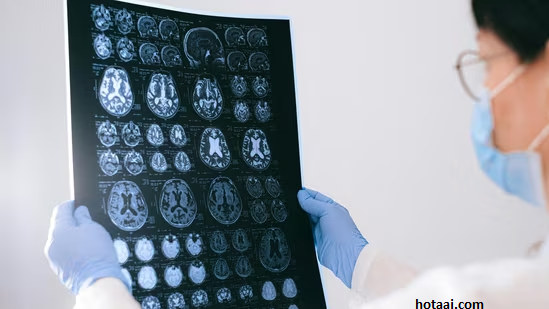The study found that aging brains show increased activity in inflammation-related genes and decreased activity in genes linked to neuron structure and function.

Scientists at the Allen Institute for Brain Science have uncovered key molecular changes in the brains of aging mice. They identified a “hot spot” where most of the age-related damage is concentrated, offering new insights into brain aging. Interestingly, the affected cells in this region are closely linked to metabolism, pointing to a potential connection between diet and brain health. This discovery highlights how dietary and lifestyle factors may play a crucial role in maintaining brain function and preventing age-related disorders. The findings could pave the way for future research on therapeutic strategies to protect the brain during aging.
Scientists at the Allen Institute have pinpointed specific cell types in the brains of aging mice that undergo significant changes over time. Their research highlights a particular “hot spot” where many of these changes are concentrated. These groundbreaking findings were published in the prestigious journal Nature. The study provides valuable insights into the molecular mechanisms underlying brain aging and could potentially lead to advancements in understanding age-related brain disorders.
The study revealed that in aging brains, genes linked to inflammation became more active, while genes associated with neuronal structure and function showed decreased activity. This shift in gene activity may contribute to the cognitive decline and neurological impairments often seen in aging.
“Our hypothesis is that those cell types are becoming less efficient at integrating signals from our environment or from things that we’re consuming,” said Kelly Jin, Ph.D., a scientist at the Allen Institute for Brain Science and the lead author of the study. This suggests that as we age, the brain’s ability to process external and internal signals may decline, potentially contributing to age-related cognitive changes.
“And that loss of efficiency somehow contributes to what we know as aging in the rest of our body. I think that’s pretty amazing, and I think it’s remarkable that we’re able to find those very specific changes with the methods that we’re using,” added Kelly Jin, Ph.D. This breakthrough emphasizes the interconnectedness of brain aging and overall bodily aging, highlighting the significance of the research methods used to uncover these precise molecular changes.
Diet, lifestyle and brain ageing:
Through this study, scientists discovered a potential link between diet, lifestyle factors, brain aging, and the molecular changes that could influence our susceptibility to age-related brain disorders. The findings suggest that what we consume and how we live may play a significant role in shaping the brain’s health as we age, opening up new avenues for preventive measures and treatments.
The researchers identified a specific “hot spot” in the hypothalamus where both a decrease in neuronal function and an increase in inflammation were observed. The most notable gene expression changes were found in cell types located near the third ventricle of the hypothalamus, including tanycytes, ependymal cells, and neurons. These cells are known for their crucial roles in food intake, energy homeostasis, metabolism, and the way our bodies process nutrients, highlighting a potential link between metabolic processes and brain aging.
To conduct the study, funded by the National Institutes of Health (NIH), researchers employed cutting-edge single-cell RNA sequencing and advanced brain-mapping tools developed through NIH’s BRAIN Initiative. These technologies enabled the team to map over 1.2 million brain cells from both young (two months old) and aged (18 months old) mice across 16 broad brain regions, providing a comprehensive view of the molecular changes associated with aging in the brain.
The aged mice used in the study are considered to be the equivalent of late middle-aged humans. Mouse brains share numerous similarities with human brains, including structure, function, genes, and cell types, making them an effective model for studying age-related changes in the brain. This similarity allows scientists to gain valuable insights into human brain aging and potential ways to mitigate related disorders.
The scientists believe that the results of this study could pave the way for future therapies aimed at slowing or managing the aging process in the brain. By understanding the molecular changes associated with brain aging, researchers hope to develop targeted treatments that could help preserve cognitive function and reduce the risk of age-related brain disorders.
Courtesy: PLANTSTRONG by Engine 2
References
- ^ Jump up to:a b “Retail store Lifestyle International FY23 profit jumps to Rs 700 cr”. Business Standard. Retrieved 28 June 2024.
- ^ “Jobs in Lifestyle, Lifestyle”. careers.lifestylestores.com. Retrieved 10 January 2024.
- ^ “Lifestyle International Expects Turnover Of Over $1 Billion In 2016-17”. Bloomberg Quint. Retrieved 5 October 2017.
- ^ “Great Place to Work in 2015 | India’s Best Companies to Work in 2015”. The Economic Times. Retrieved 5 October 2017.
- ^ “Lifestyle International Pvt. Ltd. Appoints Shital Mehta as Managing Director”. Retrieved 18 June 2018.
- ^ ETRetail.com. “Landmark Group launches an e-commerce website in India – ET Retail”. ETRetail.com. Retrieved 5 October 2017.
- ^ Malviya, Sagar (29 May 2017). “Fashion retail picks up pace again as e-commerce sites cut discounts”. The Economic Times. Retrieved 5 October 2017.
- ^ “Kangana Ranaut inaugurates new Lifestyle store – Media Infoline”. Media Infoline. 2 September 2016. Retrieved 7 October 2017.
- ^ Staff Reporter (25 March 2017). “‘Bhallaladeva’ floors his fans”. The Hindu. ISSN 0971-751X. Retrieved 7 October 2017.
- ^ “Lifestyle International to revamp its retail business in India”. The Economic Times. 22 June 2011. Retrieved 5 October 2017.
- ^ “Building a lifestyle”. Outlook Business. Retrieved 5 October 2017.
- ^ ETBrandEquity.com. “Lifestyle International bets on expansion as e-commerce threat fades – ET BrandEquity”. ETBrandEquity.com. Retrieved 7 October 2017.
- ^ Hasan, Abid. “Retail: Store Shopper”. BW Businessworld. Retrieved 7 October 2017.
- ^ “Leading the Pack- Business News”. businesstoday.in. 22 February 2017. Retrieved 7 October 2017.
- ^ Bureau, BW Online. “Summary of Lifestyle Case”. BW Businessworld. Retrieved 7 October 2017.
{{cite news}}:|last=has generic name (help) - ^ Advani, Shonali (13 July 2015). “India’s best companies to work for 2015: Lifestyle puts employees ahead of the organisation”. The Economic Times. Retrieved 7 October 2017.
- ^ “Landmark Groups announces 6th edition of ‘Beat Diabetes’ campaign”. 19 November 2015. Retrieved 8 October 2017.
- ^ “Home Centre”. 10 January 2013. Archived from the original on 10 January 2013. Retrieved 8 October 2017.
- ^ “Home Centre”. 27 December 2012. Archived from the original on 27 December 2012. Retrieved 8 October 2017.













